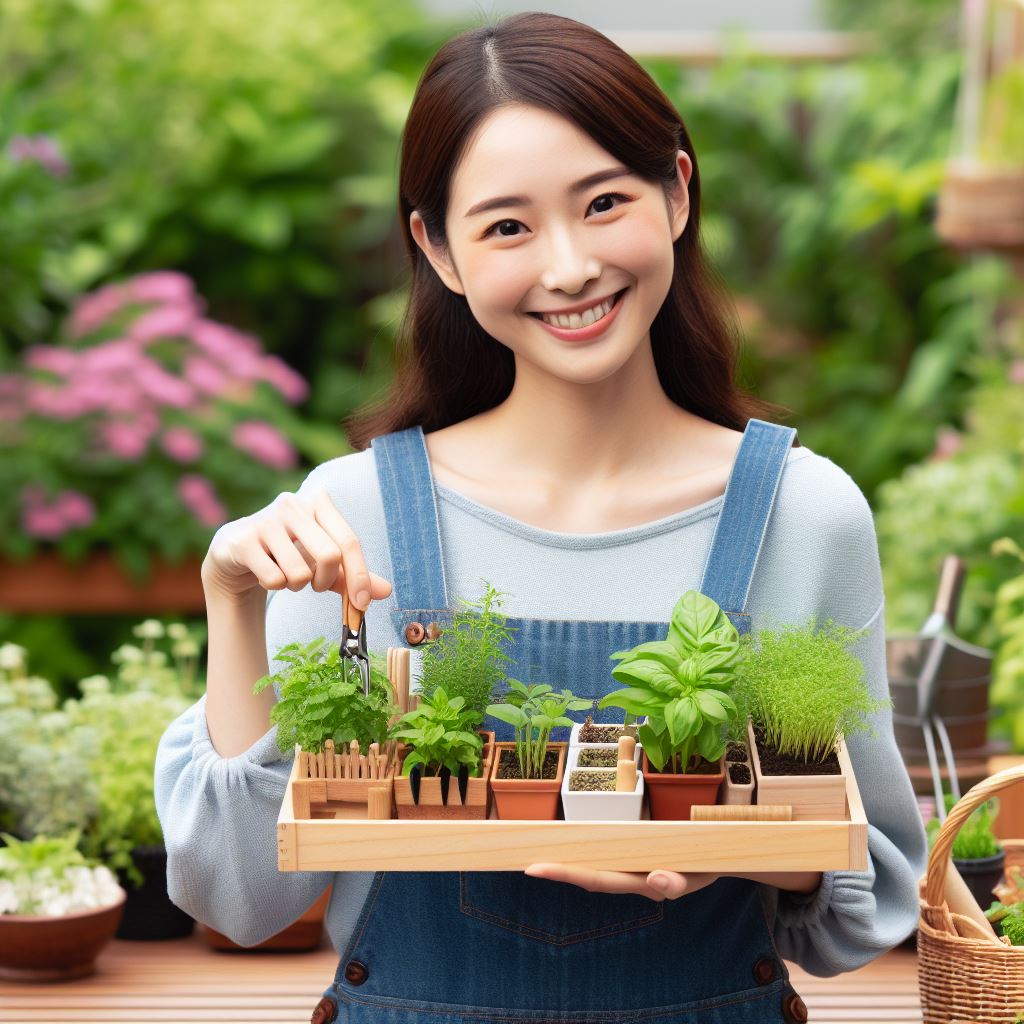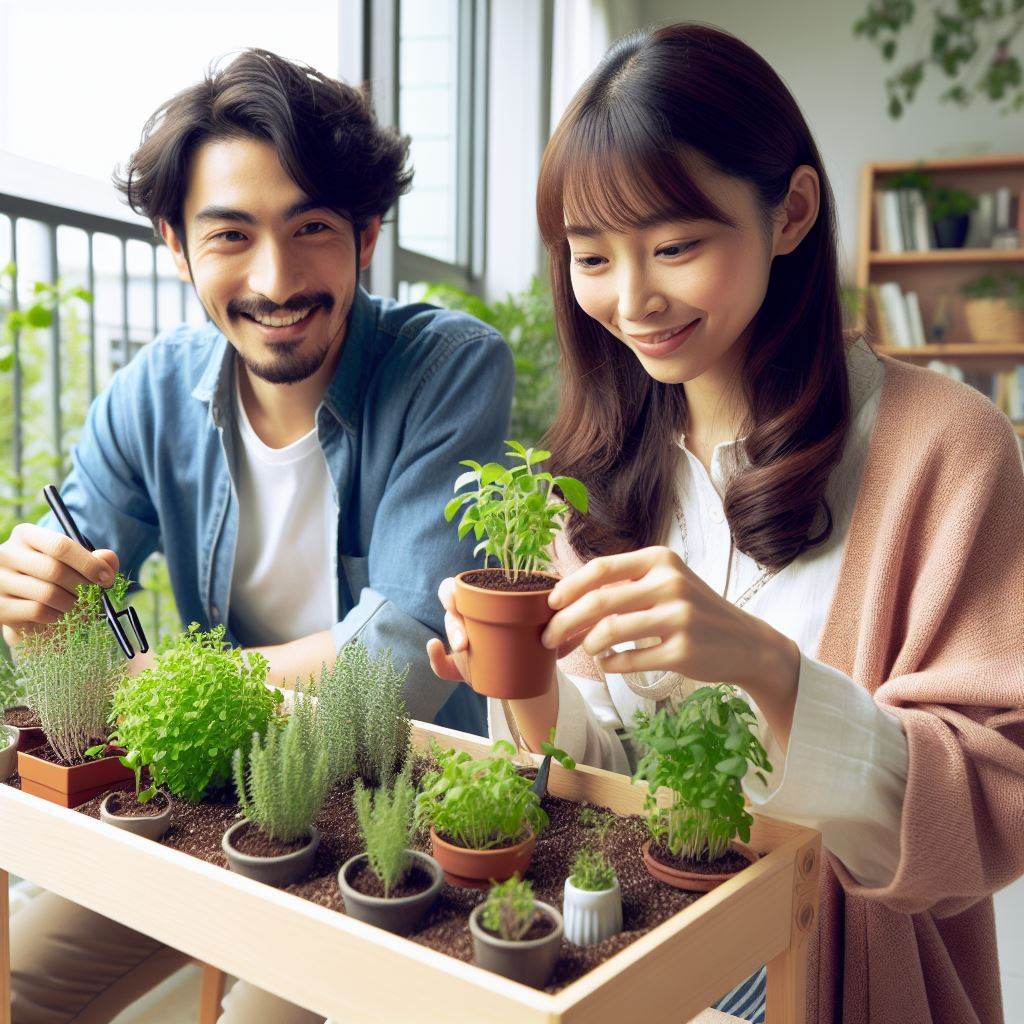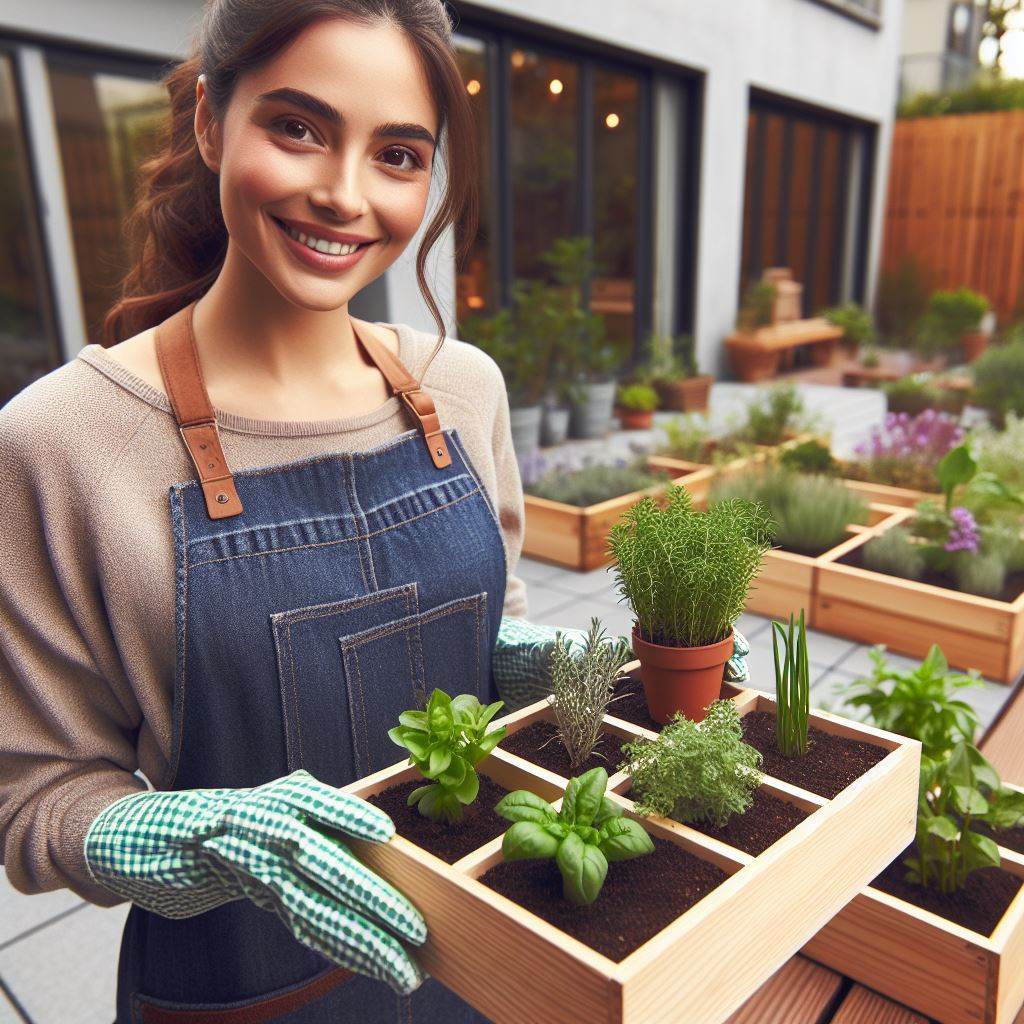Introduction
Briefly introduce the concept of compact herb gardening
In today’s fast-paced world, many people are turning to compact herb gardening as a way to bring the joy of gardening into their lives.
With limited space, this technique allows individuals to cultivate their own herbs in small areas such as balconies, windowsills, or countertops.
Benefits and growing popularity of this gardening technique
Compact herb gardening offers numerous benefits that contribute to its growing popularity.
Firstly, it provides an accessible and convenient way to have fresh herbs at hand for cooking, health remedies, or simply for their aromatic qualities.
Additionally, gardening in a compact space requires less time, effort, and resources compared to traditional gardening methods.
The increasing interest in compact herb gardening has led to an array of available resources and guides to help beginners get started.
Set the tone for a step-by-step guide to help readers get started
This step-by-step guide aims to join this helpful collection by providing detailed instructions to successfully create and maintain a compact herb garden.
Throughout this guide, we will explore various aspects, including choosing the right herbs for your space, selecting suitable containers, preparing the soil, sowing seeds or transplanting starters, and finally, properly caring for your herbs.
By following these steps, even those with limited gardening experience can achieve a thriving compact herb garden.
Whether you are a gardening enthusiast or a beginner looking to bring a touch of greenery into your life, this guide will serve as a valuable tool to help you navigate the world of compact herb gardening.
Get ready to embark on a journey filled with fresh flavors, pleasant scents, and a newfound appreciation for the wonders of nature.
Choosing the Right Location
Choosing the right location for your compact herb garden is crucial for its success.
Here are some factors to consider when selecting a suitable location:
Importance of selecting a suitable location for the herb garden
Choosing the right location is essential for the healthy growth of your herbs.
A well-planned location will provide the necessary conditions for their development and maximize their flavor and aroma.
Transform Your Agribusiness
Unlock your farm's potential with expert advice tailored to your needs. Get actionable steps that drive real results.
Get StartedAdequate sunlight
Herbs require at least six hours of sunlight each day to thrive.
When selecting a location, choose an area that receives ample sunlight, preferably in the morning or early afternoon.
Avoid places that are shaded by trees or buildings as it can hinder the herbs’ growth.
Soil quality
The soil quality plays a vital role in the overall health and productivity of your herbs.
Ensure that the soil is well-draining and nutrient-rich.
Before planting, consider conducting a soil test to determine its pH level and make necessary amendments to optimize its fertility.
Drainage
Proper drainage is crucial to prevent waterlogging, which can lead to root rot and other diseases.
Choose a location where water can drain freely, ensuring that excess moisture doesn’t accumulate around the herb plants.
Consider raised beds or containers if your garden has poor natural drainage.
Indoor or outdoor compact herb gardening based on available space
If space limitations are a concern, you can opt for indoor compact herb gardening.
Many herbs can thrive indoors with proper lighting and care.
You can use windowsills, countertop herb gardens, or grow lights to provide the necessary light for their growth.
Indoor herb gardens offer convenience, especially during colder months when outdoor gardening may not be feasible.
However, if you have ample outdoor space, you can create a compact herb garden outdoors.
This allows the herbs to benefit from natural sunlight and fresh air. Outdoor gardens offer more planting space and allow for a wider variety of herbs to be grown.
When deciding between indoor or outdoor gardening, consider the availability of space, the specific herbs you want to grow, and your personal preferences.
Therefore, selecting the right location for your compact herb garden is vital for its success.
Consider the importance of suitable sunlight, soil quality, and drainage.
Based on the available space, you can choose to have an indoor or outdoor herb garden.
By providing the optimal conditions, you will be able to enjoy fresh herbs right at your fingertips.
Happy gardening!
Read: Urban Herb Farming: Tips for Your Window Ledge
Selecting and Preparing Containers
When it comes to compact herb gardening, selecting the right containers is essential for the success of your herbs.
There are various container options available, each with their own benefits and considerations.
Showcase Your Farming Business
Publish your professional farming services profile on our blog for a one-time fee of $200 and reach a dedicated audience of farmers and agribusiness owners.
Publish Your ProfileOptions for Compact Herb Gardening Containers
- Pots: Pots are a popular choice for herb gardening due to their versatility and portability. They come in different sizes and materials, including terracotta, plastic, and ceramic.
- Hanging Baskets: Hanging baskets are an excellent option for those with limited space. They can be hung indoors or outdoors, adding a decorative touch to your surroundings.
- Vertical Gardens: Vertical gardens are gaining popularity among herb gardeners. They utilize vertical space, allowing you to grow herbs on walls, fences, or special vertical garden structures.
Tips for Choosing the Right Containers
Choosing the right size and material for your containers is crucial for the health and growth of your herbs.
Here are some tips to consider:
- Size: Select containers that provide enough room for your herbs to grow and spread their roots. Consider the mature size of your herbs and choose containers accordingly.
- Material: Consider the pros and cons of different container materials. Terracotta pots are porous and allow better airflow, while plastic pots are lightweight and retain moisture.
Importance of Proper Drainage and Suitable Potting Mix
Proper drainage is vital for your herb plants’ health as it prevents overwatering and root rot. Here’s why it is important:
- Drainage: Ensure that your containers have drainage holes to allow excess water to escape. If your chosen container doesn’t have any holes, you can drill them yourself.
- Potting Mix: Use a well-draining potting mix specifically formulated for herbs. Avoid using garden soil, as it can be dense and may not provide adequate drainage.
Filling your containers with suitable potting mix provides essential nutrients for your herbs.
Here’s what you need to know:
- Choose a quality potting mix that is formulated for container gardening, enriched with organic matter and nutrients.
- Avoid heavy garden soils, which can become compacted and hinder root growth.
- Consider adding perlite or vermiculite to improve drainage and aeration within the potting mix.
- Regularly monitor the moisture levels of the potting mix and water your herbs accordingly.
By selecting the right containers, ensuring proper drainage, and using suitable potting mix, you are setting yourself up for success in your compact herb garden.
Now that you have your containers ready, it’s time to move on to the next step of planting and caring for your herbs.
Read: Herb Gardening 101: Perfect for Tiny Yards

Choosing Herbs to Grow
When it comes to compact herb gardening, there are several popular herbs that thrive in smaller gardens.
These herbs include basil, parsley, chives, and mint. Let’s take a closer look at each one:
Basil
Basil is a versatile herb that adds a fresh and fragrant touch to a variety of dishes.
It is easy to grow and prefers full sun, making it an excellent choice for compact gardens.
Consider planting different varieties of basil, such as sweet basil or Thai basil, to add flavor diversity to your herb garden.
Parsley
Parsley is another herb that is well-suited for compact gardens.
It is a biennial plant that can be grown as an annual in most regions.
Parsley prefers partial sun, so make sure to plant it in an area that receives at least 4-6 hours of sunlight per day.
The vibrant green leaves of parsley are not only great for garnishing dishes but also packed with nutrients.
Chives
Chives are a perennial herb that are easy to grow and perfect for compact gardens.
They prefer full sun but can tolerate partial shade.
Chives have a mild onion flavor and are commonly used in salads, soups, and as a garnish.
Planting chives alongside other herbs can help deter pests.
Mint
Mint is a fast-growing herb that thrives in compact gardens.
It is known for its refreshing fragrance and can be used in various culinary and beverage recipes.
Mint prefers partial shade and moist soil, so make sure to provide regular watering to keep the plant healthy and thriving.
Be cautious as mint can be aggressive and tends to spread quickly, so consider planting it in a container or using a root barrier.
When choosing herbs to grow in your compact garden, it’s important to consider your personal preferences and intended use of the herbs.
Think about the flavors and scents you enjoy the most and how you plan to incorporate them into your cooking.
Some herbs, like cilantro or dill, may have stronger flavors that not everyone may enjoy.
On the other hand, herbs like rosemary or thyme have a more distinct aroma that can enhance the overall ambiance of your garden.
In addition to personal preferences, it’s crucial to consider the sunlight requirements of the herbs.
Most herbs thrive in full sun, which means they need at least 6-8 hours of direct sunlight per day.
However, some herbs, like mint or parsley, can tolerate partial shade.
Take note of the microclimate in your garden and select herbs accordingly.
Combining herbs with similar sunlight requirements will ensure they grow well together.
Lastly, consider the compatibility of the herbs you choose to grow.
Some herbs, like mint, have a tendency to spread aggressively and can crowd out other plants.
It’s a good idea to grow mint in a separate container or use a root barrier to prevent it from taking over your garden.
On the other hand, herbs like basil and parsley can coexist peacefully and even benefit from each other’s presence.
For instance, planting basil near tomatoes can improve the flavor and growth of both plants.
By selecting herbs that thrive in compact gardens, considering personal preferences, and taking into account sunlight requirements and compatibility, you can create a flourishing and abundant herb garden in even the smallest of spaces.
Showcase Your Farming Business
Publish your professional farming services profile on our blog for a one-time fee of $200 and reach a dedicated audience of farmers and agribusiness owners.
Publish Your ProfileRead: Small Garden, Big Flavor: Growing Herbs Easily
Planting and Caring for Herbs
Growing your own herbs can be a rewarding and cost-effective way to add fresh flavors to your meals.
Whether you’re a beginner or an experienced gardener, here are the steps for planting and caring for herbs:
Sowing Seeds or Transplanting Seedlings
- Prepare the soil by removing any weeds and loosening it with a garden fork.
- If you choose to sow seeds, follow the instructions on the seed packet for the specific herb.
- For transplanting seedlings, dig a hole that is slightly larger than the root ball of the seedling.
- Place the seedling in the hole, backfill with soil, and gently firm it around the base of the plant.
Proper Spacing, Watering, and Fertilizing Techniques
- Space your herbs according to their growth habit and size. Most herbs need 12-18 inches of space between each plant.
- Water your herbs regularly, keeping the soil evenly moist but not waterlogged. Avoid overhead watering to prevent diseases.
- When it comes to fertilizing, herbs generally don’t require heavy feeding. Use a balanced organic fertilizer once a month.
- Consider using a layer of organic mulch around your herbs to retain moisture and suppress weeds.
Regular Pruning and Maintenance for Healthy Growth
- Pruning is essential for herb plants to maintain their shape, prevent legginess, and encourage bushier growth.
- Start pruning your herbs when they reach a height of 6-8 inches. Use clean, sharp scissors or pruning shears.
- Trim the top one-third of the herb stems, just above a leaf node, to promote branching.
- Regularly remove any dead or yellowing leaves and spent flowers to prevent diseases and divert energy towards new growth.
- Perform periodic maintenance tasks like weeding, checking for pests, and providing support for tall herbs like basil.
By following these steps and giving your herbs the care they need, you’ll be rewarded with a bountiful and thriving herb garden.
Enjoy the flavors and fragrances that fresh herbs bring to your cooking!
Read: Maximize Your Balcony: Top Herbs for Small Spaces
Troubleshooting Common Issues
Compact herb gardening offers numerous benefits, but it’s not without its challenges.
In this section, we will address some common problems faced in compact herb gardening and provide tips and natural remedies to manage these issues without harmful chemical treatments.
Additionally, we will emphasize the importance of early detection and prevention for a successful herb garden.
Pests
Pests can wreak havoc on your compact herb garden, causing damage to leaves, stems, and even roots.
Some common garden pests include aphids, slugs, snails, and spider mites.
- Regularly inspect your plants for signs of pest infestation, such as holes in leaves or a sticky residue.
- Encourage natural predators like ladybugs and birds to help control pest populations.
- Apply organic insecticidal soaps or create homemade solutions using ingredients like neem oil or garlic to repel pests.
Diseases
Diseases can quickly spread among compact herb plants, leading to wilting, discoloration, and stunted growth.
Common diseases in herb gardens include powdery mildew, root rot, and fungal infections.
- Ensure proper spacing between plants to promote airflow and reduce moisture levels, which can contribute to disease development.
- Water your herbs at their base rather than overhead to prevent foliage from becoming wet, which can encourage fungal growth.
- If diseases persist, apply organic fungicides containing ingredients like copper or sulfur.
Nutrient Deficiencies
Compact herb gardens often face nutrient deficiencies due to limited space for roots and the frequent harvesting of leaves, which depletes the plants’ nutrient reserves.
Common deficiencies include lack of nitrogen, phosphorus, and potassium.
- Regularly amend your soil with organic matter such as compost or well-rotted manure to replenish nutrients.
- Fertilize your herbs with organic, slow-release fertilizers to provide a steady supply of nutrients over time.
- Consider using liquid organic fertilizers or foliar sprays for quick absorption and targeted nutrient delivery.
Early Detection and Prevention
Early detection and prevention are key to maintaining a healthy compact herb garden.
By identifying issues early on, you can take action before they escalate and become more challenging to address.
- Regularly inspect your plants for any signs of distress, such as wilting, discoloration, or unusual growth patterns.
- Introduce good gardening practices, such as proper watering, pruning, and sanitation, to prevent the onset of common issues.
- Rotate your herb crops each year to reduce the risk of pests and diseases building up in the soil.
In essence, compact herb gardening may present its share of challenges, but with the right knowledge and proactive measures, you can troubleshoot and manage common issues effectively.
By utilizing organic remedies, promoting early detection, and focusing on prevention, you can ensure a thriving and bountiful herb garden.
Harvesting and Using Fresh Herbs
When it comes to harvesting herbs, timing is everything.
The best time to harvest herbs is in the morning when the dew has dried but before the sun is too high in the sky.
When cutting or plucking herbs, make sure to use sharp, clean scissors or shears.
Cut just above a set of leaves or nodes to encourage new growth.
Guidance on storing and drying herbs for long-term use
Storing and drying herbs properly is crucial for long-term use.
One method is to hang them upside down in a cool, dark place until they are completely dry.
Alternatively, you can remove the leaves from the stems and spread them out on a clean, dry surface to air dry.
Once dry, store them in airtight containers away from direct sunlight.
Now that you have a stockpile of fresh herbs, it’s time to put them to good use in the kitchen!
Suggest various ways to utilize fresh herbs in cooking, teas, or homemade remedies
Fresh herbs can add a burst of flavor to any dish.
For savory dishes, consider adding chopped herbs like thyme, rosemary, or basil to enhance the taste.
Combine them with olive oil, garlic, and salt for a delicious herb-infused oil.
If you love making homemade teas, fresh herbs can elevate your tea game to a whole new level.
Mint, chamomile, and lemon balm make refreshing and soothing herbal teas.
Aside from cooking, fresh herbs can be used to create homemade remedies.
Infuse herbs like lavender or chamomile in carrier oils to make soothing massage oils or balms.
Dried herbs can also be used to make herb sachets or potpourris to freshen up your home.
Mix dried lavender, rosemary, and lemon verbena for a calming and fragrant blend.
Preserving the flavors of herbs through vinegar or honey infusions is another fantastic way to utilize fresh herbs.
These infusions can be used in dressings, marinades, or for sweetening beverages.
Using fresh herbs in homemade cocktails is a trend that has gained popularity in recent years.
Showcase Your Farming Business
Publish your professional farming services profile on our blog for a one-time fee of $200 and reach a dedicated audience of farmers and agribusiness owners.
Publish Your ProfileMuddle herbs like mint or basil into your favorite drink for an added twist.
Whether you have a windowsill garden or a sprawling herb bed, the possibilities for using fresh herbs are endless.
Get creative in the kitchen and explore their versatile flavors!
Remember, harvesting fresh herbs at their peak, properly storing and drying them, and incorporating them into various recipes will ensure that you enjoy their flavors all year round.
Conclusion
To recap, this step-by-step guide for compact herb gardening has covered all the necessary points.
We’ve discussed choosing the right containers, selecting the perfect spot for sunlight, and ensuring proper drainage for the herbs to thrive.
We’ve also touched upon the essential aspects of soil, watering, fertilizing, and harvesting your herbs.
Encourage readers to start their own compact herb garden and enjoy the benefits of fresh herbs
Now that you’re equipped with all the knowledge and guidance, it’s time to start your own compact herb garden.
Experience the joy and satisfaction of growing your own fresh herbs right at your doorstep.
Not only will you have a steady supply of aromatic and flavorful herbs, but you’ll also enjoy the numerous health benefits they provide.
Gardening is not just a hobby; it’s a way to connect with nature and find peace in the midst of our busy lives.
As you embark on this exciting journey of growing your own compact herb garden, remember to appreciate the wonders of nature and the therapeutic effects of nurturing plants.
End with a positive and inspiring note on the joy of gardening and the potential to explore further gardening topics in the future
Furthermore, this guide is just the beginning of your gardening adventures.
There is a vast world of gardening topics waiting to be explored.
You can delve into other types of gardening, such as vegetable gardening or flower gardening.
You can also discover innovative techniques, experiment with different plants, and learn about preserving and utilizing your herbs in recipes.
So, don’t stop with this guide.
Keep exploring and expanding your knowledge in the realm of gardening.
It’s a never-ending source of joy and inspiration, and you’ll continue to reap the rewards of your efforts for years to come.
Start your compact herb garden today and unlock the true potential of gardening.
Enjoy the freshness, flavors, and endless possibilities!




